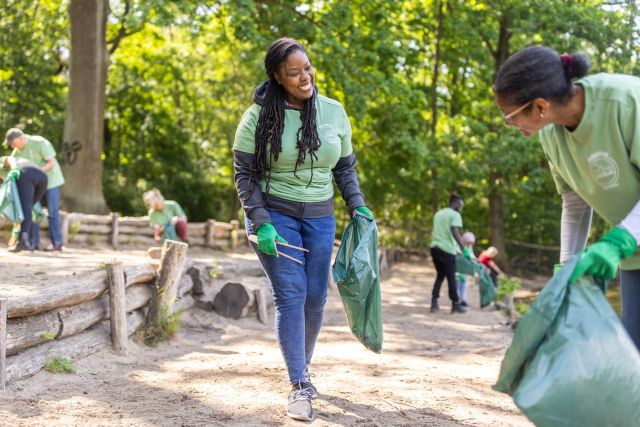Updated on May 21, 2024.
If the health of our planet is keeping you up at night, you’re not alone. Every day seems to bring new reminders of how fragile our environment is. National news, social media feeds, and smartphone notifications offer continuous updates on extreme weather events and the impacts of climate change. What’s more, many of us are experiencing the crisis firsthand, as heat, natural disasters, and other climate threats affect our lives and livelihoods.
For many, the climate crisis brings a range of negative emotions known as “eco-anxiety.” But anxiety is not the only emotion people feel. Other feelings can include grief, sadness, numbness, and anger. At least for now, though, “eco-anxiety” is the term most experts use to describe the mental health effects of climate change.
It’s worth noting that eco-anxiety is different from the mental health condition anxiety, also known as generalized anxiety disorder. Learn more about the symptoms and treatment options for generalized anxiety disorder.
What is eco-anxiety?
There are many definitions of eco-anxiety, says Kimberly A. Gray, PhD, Health Scientist Administrator for the National Institute of Environmental Health Sciences in Durham, North Carolina. Among these, the definition from the American Psychological Association (APA) is increasingly considered the standard.
The APA defines eco-anxiety as “a chronic fear of environmental doom.” For some people, eco-anxiety can be a mild form of fear that doesn’t interfere with daily living. For others, it can become severe enough to affect their life, work, and relationships. In severe cases, negative emotional responses related to climate change may activate or worsen other underlying mental health conditions.
Eco-anxiety is not yet included in the Diagnostic and Statistical Manual of Mental Disorders (or DSM), the guide used by mental health professionals to diagnose conditions. “Some scholars say climate fear shouldn’t be considered a disorder,” says Gray. “That’s because it’s often a rational response to an emerging or immense danger.” In fact, treatment for eco-anxiety often involves listening to and validating people’s concerns as real.
“There are no set guidelines on when to say a mild form of eco-anxiety should be considered a ‘regular’ response to climate threats—and when a more severe form should be considered an ‘irregular’ response,” Gray explains.
What we do know is that a common experience for a lot of people is fear or strong emotion about the human inaction—particularly the political inaction—that tends to surround climate change, Gray says. In other words, you might feel even more angry or sad when you notice that other people don’t seem to be as worried about climate change as you are.
Who is affected by eco-anxiety?
Anyone can experience eco-anxiety. But feelings of frustration over the inaction of others can be intense for children and teens. They face a future of potential consequences from climate change but have had nothing to do with the human behaviors that have contributed to it. “Think about the unfairness and injustice of these dynamics in their daily lives,” says Gray.
Children and teens may feel they have little or no power to change family or household habits that affect the environment (such as which car to drive) or to influence the policies that play a role in climate change. When parents, caregivers, and other adults dismiss children’s fears or don’t fully listen, it can be a source of great stress.
The belief that adults and people in power aren’t listening is widespread among young people. In a global study including more than 10,000 teens and young people ages 16 to 25 across 10 countries, 75 percent of participants felt the future was “frightening” and 83 percent indicated that “people have failed to take care of the planet.” Young people reported dissatisfaction with government responses to the climate crisis and that they felt more “betrayed” than “reassured.”
Eco-anxiety is common among people and communities of color, as well. Unequal access to mental health care and the fact that communities of color bear an unequal burden of environmental injustice contribute to this risk.
For example, a history of housing inequities—such as segregation and under-investment in communities of color—often leads to environmental threats taking a greater toll on communities of color today. Regulations may allow highways or factories to be built in or near communities. And housing laws may not protect people from dangerous construction practices.
These factors can contribute to serious health effects, as well as loss of life and property when extreme weather and natural disasters occur. What’s more, disparities in mental health resources and cultural stigmas around mental illness can make it difficult to for people and communities of color to access care.
Learn more about the health effects of racism and find mental health resources in the section “Give voice to your fears,” below.
Amid the climate crisis, there is power in community
Living with eco-anxiety can feel isolating, especially if those around you deny the current and future realities of climate change. Even if this is the case, know that you are not alone.
Globally, 59 percent of young people are “extremely worried” about climate change and 89 percent are at least “moderately worried.” Plenty of adults are concerned, too. In the United States, at least 69 percent of adults are worried about climate change and 49 percent believe their own lives will be affected by it.
These numbers matter because simply knowing that large numbers of people care about this issue can help counteract feelings of isolation and frustration. In fact, a key aspect of helping people cope with eco-anxiety is to connect them with others who live with climate fear. There is power in community.
Coping with eco-anxiety—and taking action
“For many people, eco-anxiety itself is a coping mechanism,” says Gray. It can be a productive response to a real issue facing our communities. “People recognize, ‘I am going to live on this planet for another 20 years, 30 years, more. What are we doing about this?’ Eco-anxiety can be the mechanism that leads people to say, ‘I’m going to do something about it.’”
The following strategies can help to reduce feelings of eco-anxiety:
Give voice to your fears
Most people can benefit from routine talk therapy with a counselor. For people with eco-anxiety, talk therapy is key because it offers a place to express concerns and hear that your worries are valid. A counselor can help you reframe worries and think about climate change in ways that offer a sense of purpose and hope for the future.
There is a national alliance of counselors who provide care for people with eco-anxiety. The Climate Psychology Alliance’s searchable directory can help you find a therapist near you who specializes in eco-anxiety. The Black Emotional and Mental Health Collective offers a range of services and resources, including a searchable directory of Black therapists. Inclusive Therapists offers a range of counseling resources, as well.
If you don’t have access to therapy or the resources to pay for counseling, the Substance Abuse and Mental Health Services Administration (SAMSHA) may be able to help. Their national helpline is available 24/7, with phone, text, and TTY options (for people with speech or hearing impairments). Services are available in English and Spanish. Dial 1-800-662-HELP (4357) to find out about low- or no-cost therapy options. For TTY, dial 1-800-487-4889.
Connect with others
“There have been studies to suggest that if you are engaged in collective action, that sense of community can weaken the link between climate change and anxiety because it can help you realize you are not alone in this—and you don’t have to remain alone,” says Gray.
A therapy group and/or climate action group can support you and help you understand complex emotions, including climate anxiety and ecological grief, often while taking meaningful action together. The Work That Reconnects is one national network of support groups that focuses on environmental healing. This network follows a wellness model that weaves together several approaches including group therapy, environmental workshops, a step-by-step process for coping with environmental stress, and volunteering.
Volunteer
“For many people with eco-anxiety, it helps to be involved in the effort to stop climate change. You might say, well, what can I do? But even if you take small actions in your own life or at the community level, it can help to remove that feeling of helplessness, that lack of control,” explains Gray.
One personal change might include reducing the amount of meat you eat. The meat industry contributes to climate change by releasing earth-warming gases—and is also harmful to animals. Another example could be to opt for clean transportation (like biking or walking) when possible instead of gas-burning transportation (like driving).
At the community level, options could include helping to plant a community garden, working at a local wildlife rehabilitation center, or speaking up and voting at community planning meetings. These meetings are often where decisions about parks, gardens, and other green spaces are made. (Green spaces include any areas covered by trees, grass, or shrubs, rather than buildings.) Not sure how to find a volunteer opportunity? Several organizations have directories where you can find opportunities near you:
- The National Park Service lets you explore volunteer activities and roles according to location and areas of interest.
- Organizations such as the Sierra Club, 350.org, and Science Moms offer a broad range of climate activism and community building activities from the local to national level.
“Just be careful to start slow and don’t overcommit yourself to too many activities right away,” cautions Gray. “That could add an unhealthy amount of work or stress to your plate.”
Reconnect with nature
Spending time in nature can be a powerful reminder that there is also much to be grateful for now, despite the real threats to the future of our planet.
While the earth is suffering in many ways, it is also growing and flourishing in others. And while many people in power do little or nothing to protect the earth, there are also plenty of folks (like park rangers, volunteers, and wildlife rescuers) who are hard at work. These truths can exist at the same time. Likewise, spending time in nature when possible (whether walking, hiking, or meditating) can help you cultivate feelings of peace and gratitude while reducing the mental health impact of climate change.
Spending time in nature has been shown to help ease eco-anxiety, but doing so can be difficult or impossible for many people. In fact, it is an example of environmental injustice that not every person and community in the U.S. has access to nature. Many communities don’t have safe sidewalks or places to walk outdoors. If it’s difficult to access nature near you, there are alternative ways to get some of the mental and physical benefits of being outdoors.
Listen to kids
Finally, if you are a parent or adult caring for a young person with eco-anxiety, listen to their concerns. Show them you take their fears seriously, even if you disagree with their ideals or the extent of their worry. Think about ways to act together, such as by volunteering with them or simply getting back to nature together on your next day off.
Address your health if you have severe anxiety symptoms
Given that eco-anxiety can vary in severity, the steps listed above might not be appropriate for everyone. “If your symptoms are significant, you can’t find comfort, or your fear is increasing despite these strategies, you might need to take a different approach under the guidance of a mental health professional,” says Gray.
For example, people whose symptoms interfere with work, life, or relationships might need to seek care for an underlying condition—like generalized anxiety disorder—that is being activated or worsened by climate fears.
In addition to persistent fear or worry, symptoms of an anxiety disorder may include:
- Feeling restless, irritable, or agitated
- Trouble concentrating
- Fatigue or exhaustion
- Rapid heartbeat
- Shortness of breath
- Tense muscles or aches and pains
- Trouble falling or staying asleep
Care for an underlying mental health condition will vary based on your specific diagnosis, but it might include a combination of medication and counseling. If you are experiencing a mental health crisis, text, chat, or dial 988 to the 988 Suicide & Crisis Lifeline for free, confidential support.
This article has been written in collaboration with the Center for Children’s Health Assessment, Research Translation, and Combating Environmental Racism (CHARTER) at Emory University and the National Institute of Environment Health Sciences (NIEHS).
CHARTER works to develop strategies to translate research findings on children’s environmental health for stakeholders in the community, academia, and health care with the goal of improving children’s health. NIEHS shares research with a focus on protecting children from environmental harm through the NIEHS Collaborative Centers in Children’s Environmental Health Research and Translation (CEHRT) and provides educational resources for kids, parents, and teacher at Kids Environment Kids Health.







